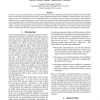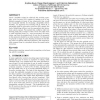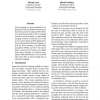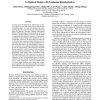89
Voted
LREC
2010
15 years 1 months ago
2010
In recent years, corpus based approaches to machine translation have become predominant, with Statistical Machine Translation (SMT) being the most actively progressing area. Succe...
108
click to vote
IIR
2010
15 years 1 months ago
2010
Given a classifier trained on relatively few training examples, active learning (AL) consists in ranking a set of unlabeled examples in terms of how informative they would be, if ...
COLING
2008
15 years 1 months ago
2008
Active learning is a proven method for reducing the cost of creating the training sets that are necessary for statistical NLP. However, there has been little work on stopping crit...
101
Voted
AAAI
2010
15 years 1 months ago
2010
Many problems in information extraction, text mining, natural language processing and other fields exhibit the same property: multiple prediction tasks are related in the sense th...
92
Voted
ACL
2008
15 years 1 months ago
2008
Active learning is a machine learning approach to achieving high-accuracy with a small amount of labels by letting the learning algorithm choose instances to be labeled. Most of p...
96
Voted
AAAI
2010
15 years 1 months ago
2010
In many real world applications, labeled data are usually expensive to get, while there may be a large amount of unlabeled data. To reduce the labeling cost, active learning attem...
84
Voted
ACL
2008
15 years 1 months ago
2008
We extend the classical single-task active learning (AL) approach. In the multi-task active learning (MTAL) paradigm, we select examples for several annotation tasks rather than f...
75
Voted
ALT
2010
Springer
15 years 2 months ago
2010
Springer
We explore a general Bayesian active learning setting, in which the learner can ask arbitrary yes/no questions. We derive upper and lower bounds on the expected number of queries r...
112
Voted
FOIKS
2008
Springer
15 years 2 months ago
2008
Springer
Supervised learning deals with the inference of a distribution over an output or label space Y conditioned on points in an observation space X , given a training dataset D of pair...
77
Voted
COLT
2008
Springer
15 years 2 months ago
2008
Springer
We describe and explore a new perspective on the sample complexity of active learning. In many situations where it was generally believed that active learning does not help, we sh...




